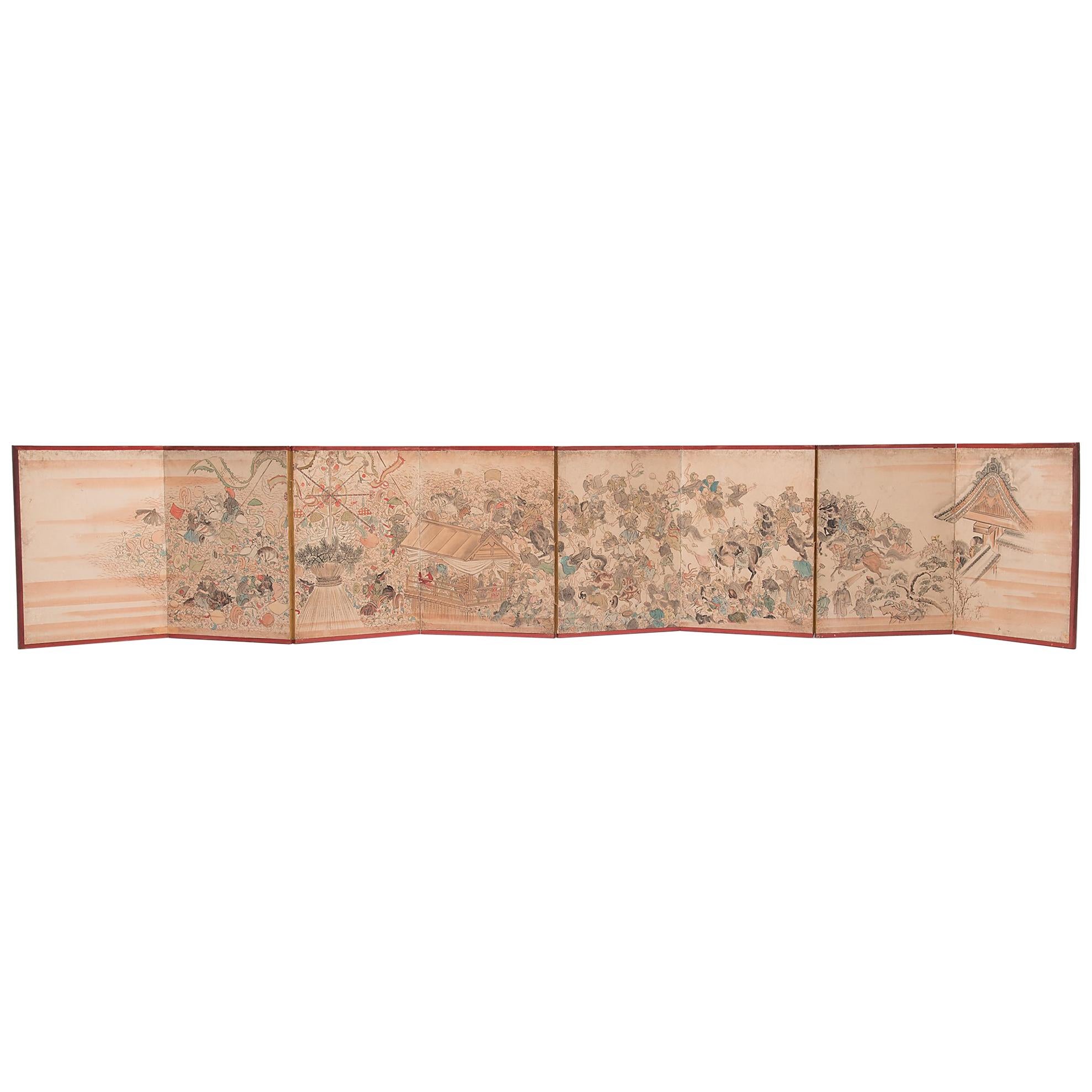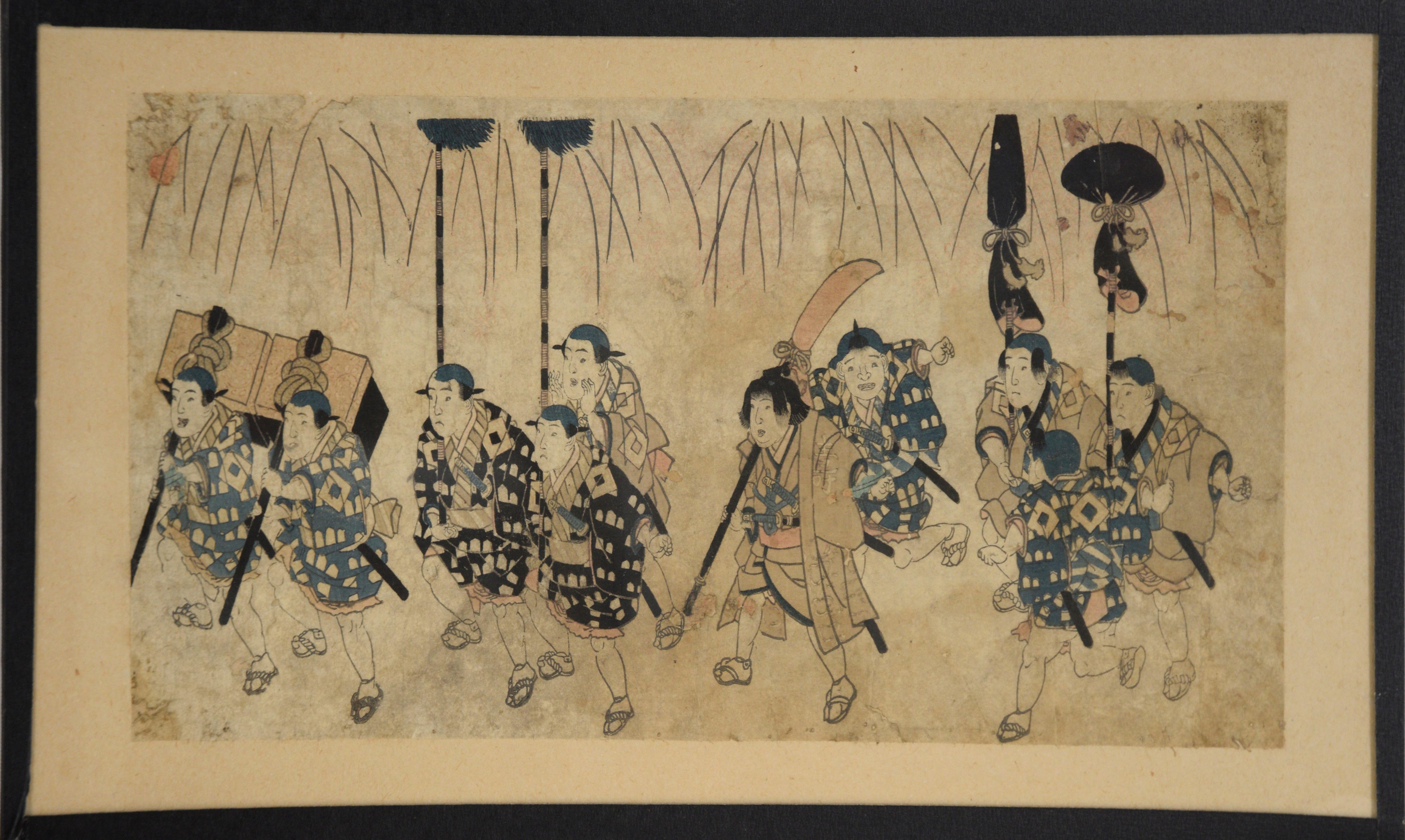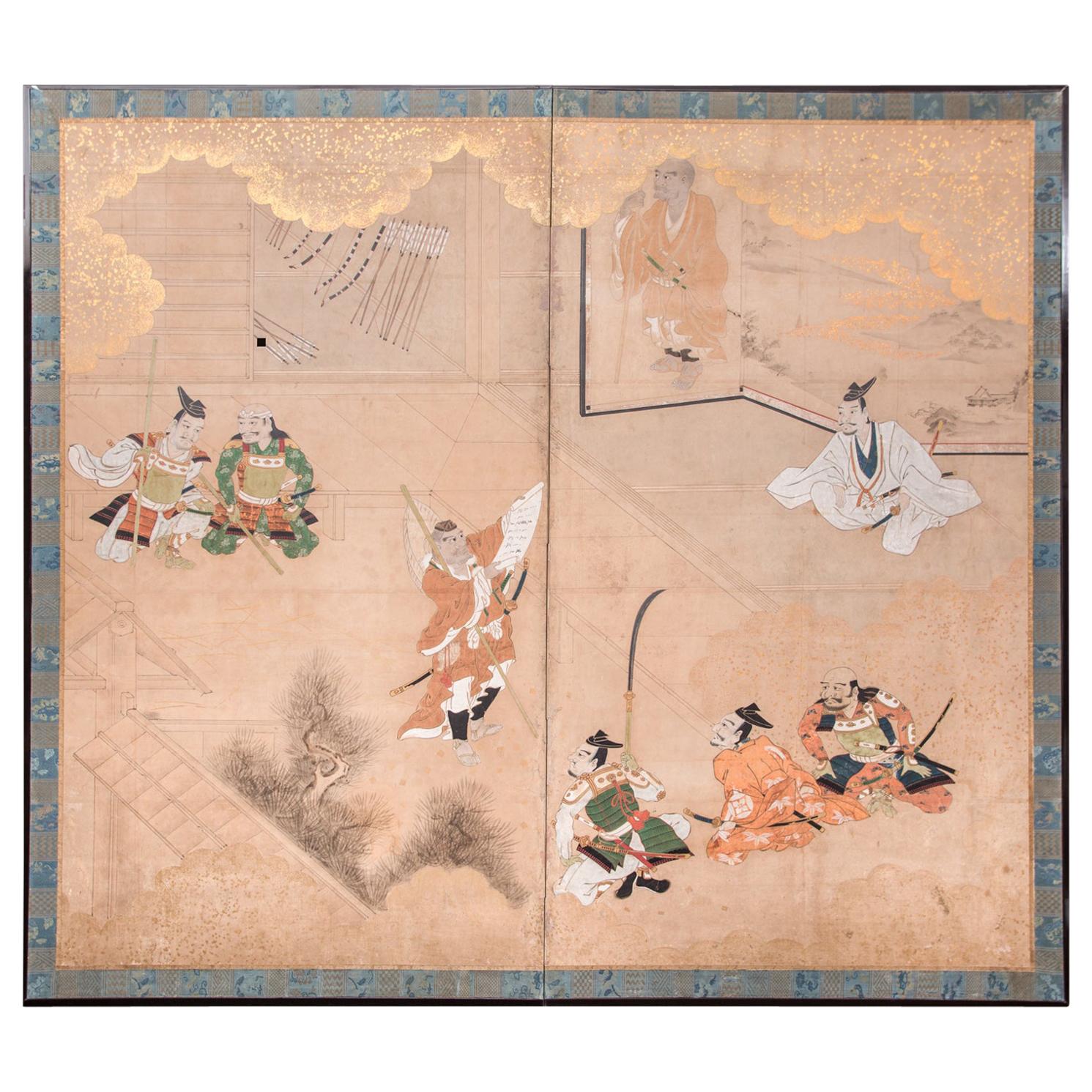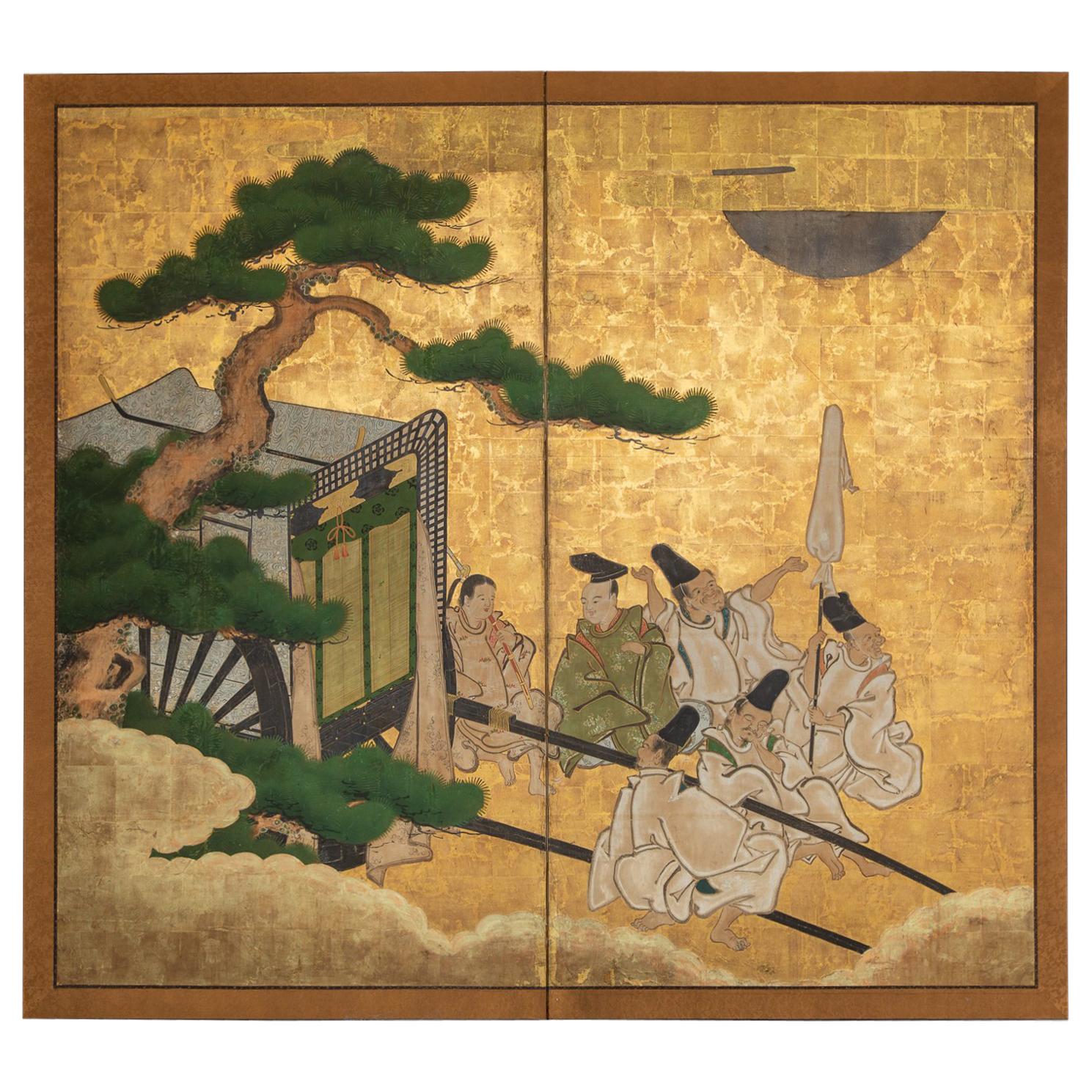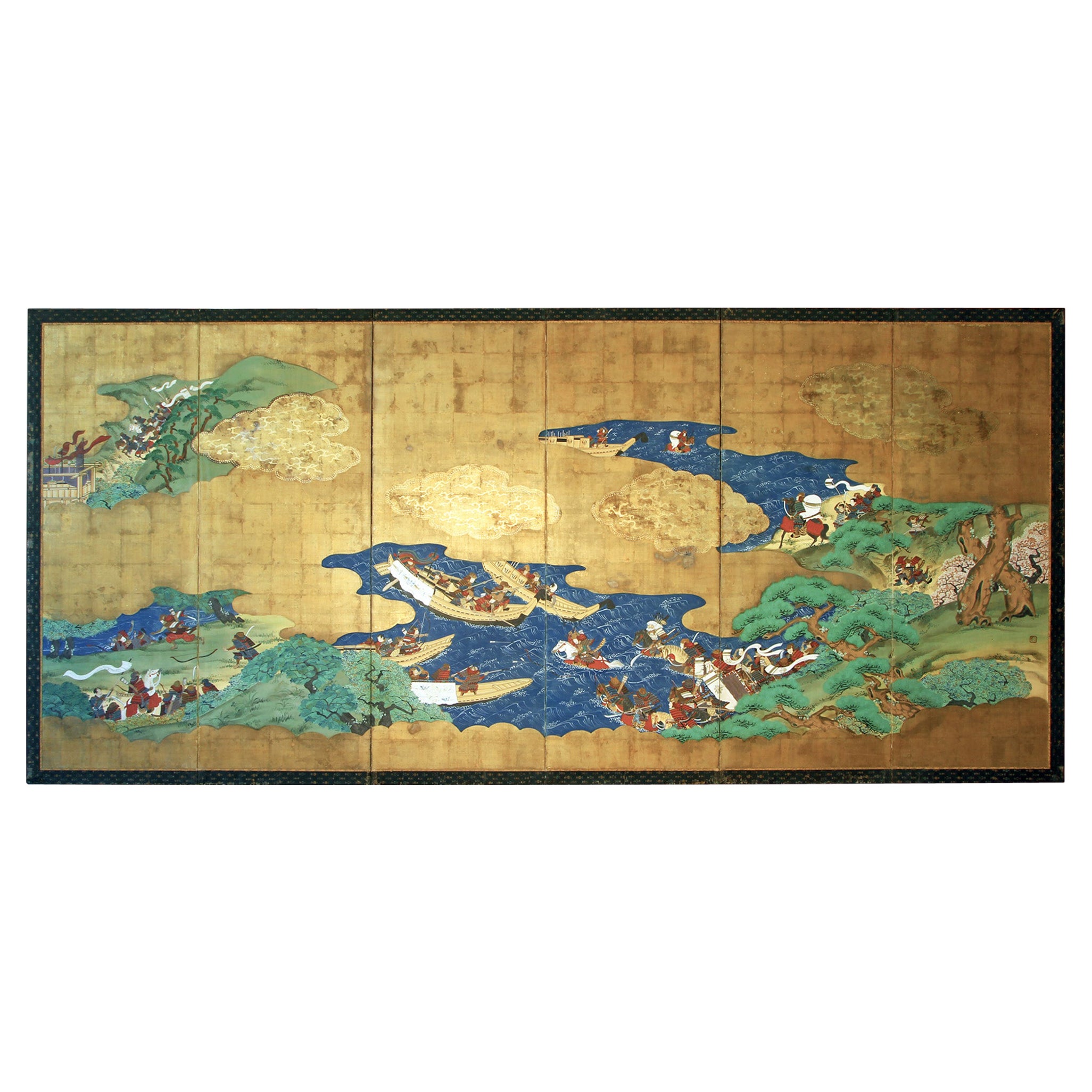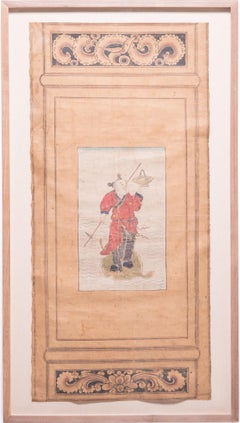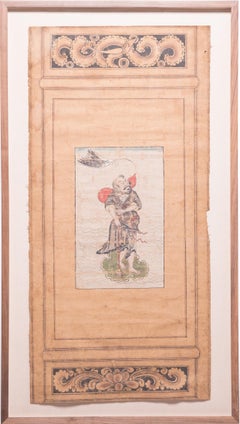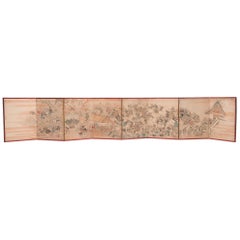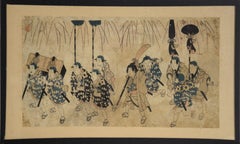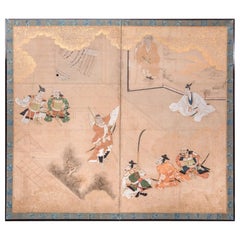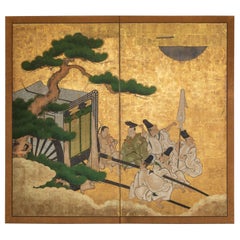Items Similar to Japanese Festival Folding Screen, Paint on Paper
Want more images or videos?
Request additional images or videos from the seller
1 of 12
UnknownJapanese Festival Folding Screen, Paint on PaperMid-18th Century
Mid-18th Century
$9,280
£7,042.79
€8,112.27
CA$13,261.20
A$14,554.04
CHF 7,505.93
MX$173,858.53
NOK 95,114.03
SEK 89,126.27
DKK 60,583.36
About the Item
This folding screen is a stunning example of Japanese artistry. Beautifully painted with delicate brushwork, the evocative screen depicts a lively festival during the Edo period (1615–1912). The raucous scene is full of life; within the dense crowd, you can make out people dancing, playing instruments, riding horseback, and waving banners. Each of the eight panels is completely unique and painted with exquisite detail. Given the fragility of paper artworks, a screen of this age and quality is a rare and extremely rewarding discovery.
- Creation Year:Mid-18th Century
- Dimensions:Height: 0.75 in (1.91 cm)Width: 143.5 in (364.49 cm)Depth: 23.75 in (60.33 cm)
- Medium:
- Movement & Style:
- Period:
- Condition:
- Gallery Location:Chicago, IL
- Reference Number:Seller: SUP0011stDibs: LU1036310280142
About the Seller
5.0
Gold Seller
Premium sellers maintaining a 4.3+ rating and 24-hour response times
1stDibs seller since 2018
33 sales on 1stDibs
Typical response time: 12 hours
- ShippingRetrieving quote...Shipping from: Chicago, IL
- Return Policy
Authenticity Guarantee
In the unlikely event there’s an issue with an item’s authenticity, contact us within 1 year for a full refund. DetailsMoney-Back Guarantee
If your item is not as described, is damaged in transit, or does not arrive, contact us within 7 days for a full refund. Details24-Hour Cancellation
You have a 24-hour grace period in which to reconsider your purchase, with no questions asked.Vetted Professional Sellers
Our world-class sellers must adhere to strict standards for service and quality, maintaining the integrity of our listings.Price-Match Guarantee
If you find that a seller listed the same item for a lower price elsewhere, we’ll match it.Trusted Global Delivery
Our best-in-class carrier network provides specialized shipping options worldwide, including custom delivery.More From This Seller
View AllChinese Mythical Immortal Screen Painting, c. 1850
Located in Chicago, IL
Since the 12th century, people in China have used folding screens and doors to partition and decorate their homes - the vivid scenes backing the screens added life and color to a room. This 19th-century painting is delicately brushed of gouache and ink on fabric and was originally part of a set of eight backing a wooden screen in northern China.
The figure depicted is one of the mythical Eight Immortals of Taoism. Said to have attained immortality through their studies of the natural world, each of the Eight Immortals represents a different condition in life and together they impart a blessing of prosperity and longevity. Depicted here is immortal Lan Caihe, the patron saint of florists and gardeners. Standing atop a lotus leaf in open water, they hold a gardening hoe in one hand and a basket for flowers...
Category
Mid-19th Century Qing Figurative Paintings
Materials
Fabric, Ink, Pigment
Chinese Mythical Immortal Screen Painting, c. 1850
Located in Chicago, IL
Since the 12th century, people in China have used folding screens and doors to partition and decorate their homes - the vivid scenes backing the screens added life and color to a roo...
Category
Mid-19th Century Figurative Paintings
Materials
Fabric, Ink, Pigment
Set of Four Chinese Immortals Screen Paintings, c. 1850
Located in Chicago, IL
Since the 12th century people in China have used folding screens and doors to partition and decorate their homes—the vivid scenes backing the screens added life and color to a room. ...
Category
Mid-19th Century Qing Figurative Paintings
Materials
Fabric, Ink, Gouache
Japanese Riverside Landscape Scroll, c. 1900
Located in Chicago, IL
Although Western painting was initially embraced during Japan’s Meiji period (1868–1912), artists brought on a revival of traditional painting styles as they sought to create a moder...
Category
Early 20th Century Landscape Drawings and Watercolors
Materials
Silk, Paper, Ink
Chinese Mythical Immortal Screen Painting, c. 1850
Located in Chicago, IL
Since the 12th century, people in China have used folding screens and doors to partition and decorate their homes - the vivid scenes backing the screens added life and color to a roo...
Category
Mid-19th Century Figurative Paintings
Materials
Fabric, Ink, Pigment
Chinese Mythical Immortal Screen Painting, c. 1850
Located in Chicago, IL
Since the 12th century, people in China have used folding screens and doors to partition and decorate their homes - the vivid scenes backing the screens added life and color to a roo...
Category
Mid-19th Century Figurative Paintings
Materials
Fabric, Ink, Pigment
You May Also Like
Japanese Edo Period Festival Screen, c. 1750
Located in Chicago, IL
This 18th century folding screen is a stunning example of Japanese artistry. Beautifully painted with delicate brushwork, the evocative sc...
Category
Antique Mid-18th Century Japanese Edo Paintings and Screens
Materials
Paper
Festival Procession Of A Daimyo - Original Woodblock Print
Located in Soquel, CA
Procession Of A Daimyo - Original Woodblock Print
Original woodblock print depicting the procession of a Daimyo. Ten Japanese soldiers are seen as they aid in transporting the Daimy...
Category
Late 18th Century Edo Figurative Prints
Materials
Ink, Wood Panel, Rice Paper
Japanese Two Panel Screen: Genpei Warriors
Located in Hudson, NY
The Genpei War took place from 1180–1185, during which the Minamoto clan rebelled against the Taira clan for control of Japan. The two clans had a bitter rivalry for years, and the M...
Category
Antique Early 19th Century Japanese Edo Paintings and Screens
Materials
Gold Leaf
Japanese Two-Panel Screen, Shogun's Journey to Edo
Located in Hudson, NY
Kano school painting of nobles at rest (some yawning) under moonlit sky. Mostly likely a representation of the last story in the Ise Monogatari: chapter 16, Sekiya (The Gatehouse). A...
Category
Antique Mid-19th Century Japanese Paintings and Screens
Edo 19th Century Japanese Folding Screen Six Panels Battle of Menpei
By Japanese Studio
Located in Brescia, IT
Samurai on horseback and by boat from the famous battle of Menpei Japanese folding screen six-panel of "Tosa School" painted with mineral pigments on vegetable on golden silk , earl...
Category
Antique Early 19th Century Japanese Edo Paintings and Screens
Materials
Gold Leaf
Important Japanese six-fold screen depicting The Tale of The Genji, 17th century
Located in Amsterdam, NL
An important Japanese six-fold screen, depicting episodes from The Tale of The Genji
Edo period, 17th century
Ink and colour on gilded paper, H. 155 x W. 380 cm
The Tale of Genji...
Category
Antique 17th Century Japanese Edo Paintings and Screens
Materials
Paint, Paper
More Ways To Browse
Japanese Paper Art
Japan Antique Paper
Antique Folding Screen
Japanese Ink Art
Paper Folded Art
Japanese Folding Screen Screen
19th Century Figurative Paintings Dance
Painting Of Children
Jewish Paintings
Antique Tempera Painting
Artist Raymond
Jesus Painting
Naive Art Painting
Oil Painting Dress
Soldier Painting
Uxval Gochez Gallery
Contemporary Face Painting
Italian Oil Painting Old Man
